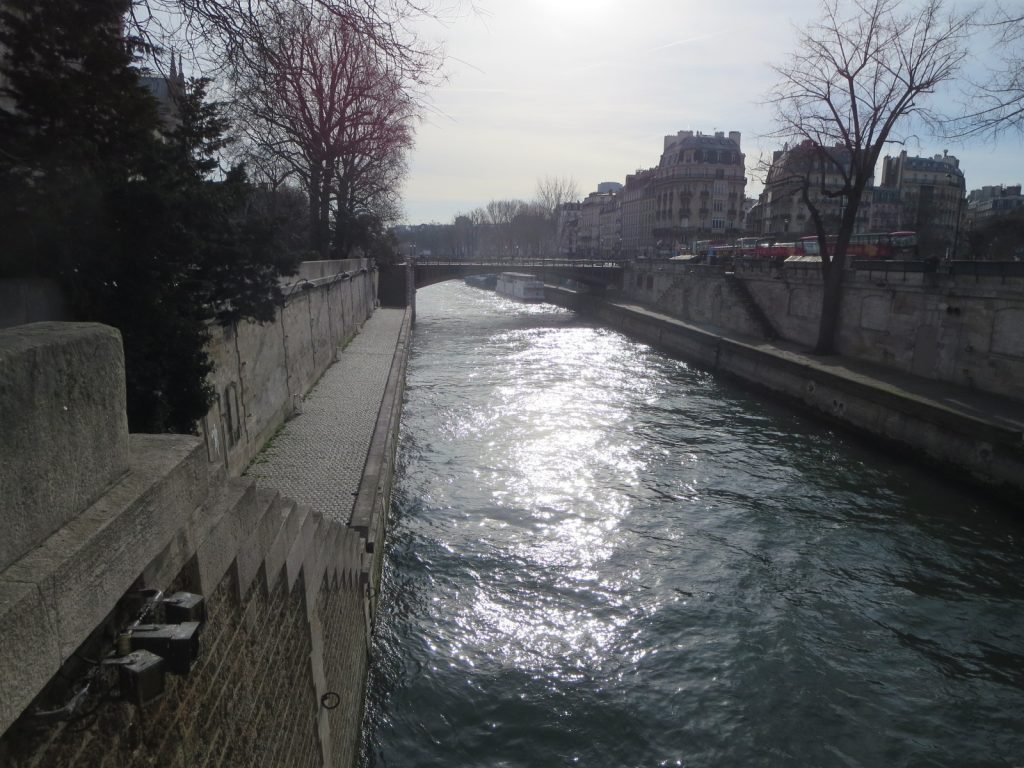Today was my first full day in Paris and I figured what better way to see it than to do, not one, but two walking tours in different parts of the city.
I went with the Sandeman’s Free Walking Tour.
I’ve done their free walking tours in a couple of other cities and they seem to know how to do things.
Along with the free walking tour at 10am I also signed up for a paid (16 euro, $22) tour of the Montmartre district which is the artsy part of tour highlighted by the Sacre Coeur and the Moulin Rouge.
If you’ve read my blog then you know I’m a big fan of free walking tours and try to go on one as the first thing I do in a new city.
It’s a great way to get your bearings straight, figure out where everything is and get ideas of where to go and what to do in a city.
Plus the stories you hear about the history of the city and the country are always educational and fun.
And with that in mind, here’s some of the highlights from the two walking tours…
The city of stink

Paris wasn’t always the gorgeous city it is now. In fact it used to be a cesspool of crowded and unhealthy medieval neighborhoods.
Oh, and there really was no sewer system so people would toss their waste out the windows at night (don’t forget to bring an umbrella).
So, yeah, Paris sucked and one day in the mid 1800’s the Emperor ordered the complete demolition of Paris so it could be rebuilt with wide avenues, parks and squares and, of course new sewers, fountains and aqueducts.
Naturally there was some opposition as people who lived there for years were given very little notice that they had to pack up and leave.
Residents ended up north in the Montmartre area but when Paris was rebuilt only the wealthy could return.
No highrises

Unlike every other major city in the world you will find a distinct lack of highrises here in Paris.
In fact, Paris bylaws only allow a maximum of 5 stories per building in the city and the reason isn’t what you would think.
You see, there’s a little matter of the hollowed out grounds beneath where the catacombs are throughout the city.
Yup, the ground isn’t stable enough to handle the weight of taller buildings!
And you thought they were being all progressive and not wanting to ruin their skyline!
Lighting up the room

Back in the day all the churches were built Roman style with big arched doorways. The problem with that though was that the buildings weren’t able to bear as much weight and therefore couldn’t be tall or have windows hollowed out in the walls.
Then the Goths came along and designed Notre Dame.
Gone were the arched doorways and in it’s place were angled doorways that could bear alot more weight.
Not only could the church now be grander but they were able to put windows into the structure.
Oooooo, windows, you say? Whoop de doo!
Well, turns out the windows now let in natural light which brightened up the church which brought people over to Catholicism.
So, yeah, windows, the new recruiting tool of the Catholics…
Cast the first stone

Pont Neuf, when translated, means New Bridge.
Ironically, the Pont Neuf here in Paris is actually the oldest bridge in the city.
At the time it was built though it was the new bridge in town.
It was a new bridge with a new way of looking at things. Unlike previous bridges, this one was made of stone instead of wood.
You see, back in the day, all the bridges were made of wood. Not only that, but people actually lived on the bridges in their wood homes and if a home went up in flames it took the bridge down with it.
So, amoungst much controversy, Henry IV commissioned to have the Pont Neuf built with stone instead and we haven’t looked at bridges the same way since.
You stink!
Did you know that the French only bathed a couple times a year because they thought the dirt that was covering them was actually protecting them from disease.
In fact, if they did bathe the dirt off they were put under quarantine by a doctor because now their pores were open and susceptible to disease.
Imagine their shock and horror when the Romans came into town with their Roman bath houses!
The language police
There is actually a building housing dozens of people who’s job it is is to protect the French language from English words creeping into it.
These people have been in a uproar over the last several years as slowly but surely English has been making it’s way into the French vernacular.
Le Wifi. Le Email. Le Selife. Le Hashtag.
Yeah, you get the idea…
About 10 years ago they actually had an emergency meeting when the iPod came out. Not over what to call it because, well, it was an iPod.
No, what the uproar was over was whether the iPod should be masculine or feminine.
I kid you not, they debated for days and in the end it is now known as “le iPod”.
8 percent
At any given time the art on display at the Louvre is only 8% of it’s total collection. The Louvre houses over 400,000 pieces of art but everything but 37,000 pieces are in storage and every few months they switch pieces out.
80 percent

A survey done in 2011 unearthed the shocking discovery that 80% of visitors to the Louvre only go there to see the Mona Lisa.
They rush in, battle their ways through the ridiculous crowds, take a selfie with the painting and head back out.
80 percent!
Mona Lisa
The Mona Lisa is only as famous as she is because of a certain Italian thief named Vincenzo Peruggia.
In August 1911 security wasn’t as tight as it is now and one day Vincenzo, who worked as a janitor at the Louvre, simply walked up to the painting, tucked it in his jacket and walked out with it.
It actually wasn’t until 2 days later when someone noticed it was missing.
The museum was closed for days and searched from top to bottom. When they came to the conclusion that it had, in fact, been stolen – the image of the Mona Lisa was plastered in newspapers throughout the world.
When the painting was recovered 2 years later, people now flocked here to see this now infamous painting and, so, a legend was born.
Thief or hero?
Speaking of Vincenzo Peruggia…
When he was caught in 1913 in his homeland of Florence, Italy he defended his actions by saying that he had stolen it to bring it back to it’s rightful home of Italy.
So, yeah, he did it for national pride!
The people of Italy hailed him as a national hero and he only received a short jail sentence while if he had been caught in France he would have surely lost his head.
We want gore!
When the guillotine was first introduced the French actually hated it!
You see, when there’s no HBO or Netflix, the only show in town is the regular occurring executions in the main square.
Blood. Guts. Gore.
What more could you ask for?
Well, when the guillotine was brought in as a more humane way to execute people it was met with much disdain.
It chopped off people’s heads way too easily. There was no suffering. There was no show.
Booooo!!!
Eventually, of course, the guillotine grew into favor as the preferred method of execution mainly because it could chop off another head just 90 seconds later and when there’s mass executions to take place, time is of the essence.
Pardon me
A couple things about Marie Antoinette…
The phrase most commonly attributed to her “let them eat cake” was actually never said by her and was just drummed up as propaganda by the people who opposed her and the king.
Her last words “Pardon me, I didn’t mean to do it” were not in reference to anything she had regretted doing in life but were said because she had accidentally stepped on the executioner’s foot as she was being brought to the guillotine.
Ah, Marie Antoinette, polite to the end…
Let me carry that
St Denis was famous for bringing Christianity to Paris and after awhile the Romans didn’t like what they saw.
So, in true Roman style, they captured him and in full display of everyone they chopped off his head.
St Denis wasn’t going to let a little thing like that stop him so he simply bent over, picked up his head and while carrying it in his hand he proceeded to give his best, most electric sermon.
He walked 10km, head in hand, preaching to the people before finally falling over dead where the St Denis Basilica now lies.
And, so was born a martyr.
The martyr of the mountain.
Montmartre.
And, there you go, just a few of the many stories I heard today.

















































